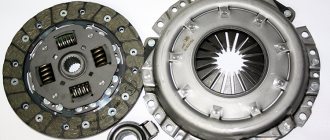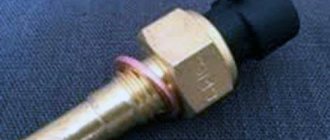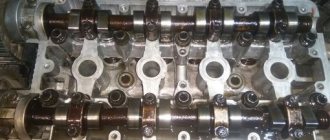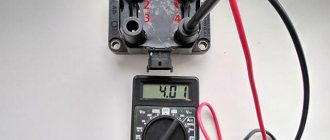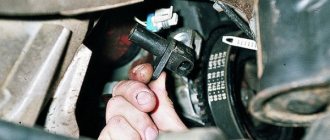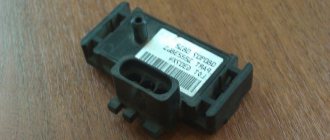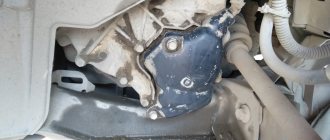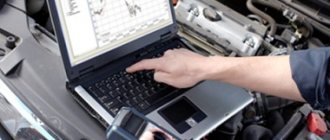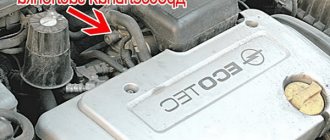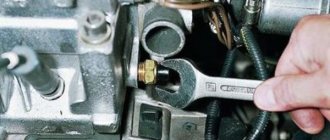Description and meaning of error P0340
This diagnostic trouble code (DTC) is a generic powertrain code. It is considered general because it applies to all makes and models of vehicles (1996-newer), although the specific repair steps may vary slightly depending on the model. So this engine code article applies to Nissan, Ford, Toyota, Chevrolet, Dodge, Honda, GMC, etc. This P0340 code indicates that a problem has been detected in the camshaft position sensorcircuit. Since it talks about the circuit, it means the problem could be in any part of the circuit - the sensor itself, the wiring, or the PCM. It's not easy to replace the CPS (camshaft position sensor) and I think it will definitely be fixed.
Reasons for the error
There are only three main causes of engine error p0340:
- Damage to the camshaft sensor wiring . In particular, we are talking about her breakup. As a rule, the DPRV has three wires - power, ground and signal. Due to certain mechanical damage, they can fray and the signal will stop going through them. Most often this happens at the terminals or at the contacts (the so-called “chips”, connected to the sensor or connectors of the electronic control unit). Another option is damage to the insulation, which causes them to short to the housing or to each other. The result of such a breakdown will be sending incorrect data to the ECU.
- Damage to the camshaft sensor . DPRV is a fairly simple and reliable device, and it rarely fails. However, when a P0340 error code signal is generated, it makes sense to check the camshaft sensor.
- Incorrect operation of the ECU . This is a fairly rare case, since if the electronic control unit partially fails, not only errors p0340 will be observed, but also many others. However, such a situation is possible, for example, if the control unit software was flashed before the error was generated (for example, when tuning the engine, installing gas equipment, etc.). Accordingly, if there were “glitches” in the firmware procedure or the software itself caused malfunctions, then the ECU may not operate correctly. In even rarer cases, the sensor installation may be misaligned or the unit may experience mechanical damage (for example, after an accident).
Sometimes the cause of error p0340 is incorrect installation of the sensor. However, this is a rather rare case, since it only has one seat. Perhaps the fastening is not strong enough (small tightening torque, which is why the sensor can vibrate when driving) or there is a large gap between the working (sensitive) part of the sensor and the so-called rapper - a tooth on the indicator wheel located on the camshaft.
Computerized Engine Management System Overview
In order for a computerized engine to run efficiently, the ECU (engine control unit) must be able to determine which cylinder is on the compression stroke and ignite the spark at the right time in that cylinder to ensure maximum combustion. The ECU must also be able to determine which cylinder is on the intake stroke so that fuel can be injected into that cylinder at the right time (and, through other sensors, the right amount of fuel).
This is made possible by the combination of the Crankshaft Position Sensor (CKPS) and the Camshaft Position Sensor (CMPS).
CKPS monitors the angular position of the crankshaft and sends a signal to the ECU, which allows it to determine the position of the piston in each cylinder. The CMPS, on the other hand, monitors the camshaft position (or actually the valve position) and sends this information to the ECU.
Through these two signals, the ECU can determine which cylinder is on the compression stroke and which is on the intake stroke. This is, of course, provided that the crankshaft and camshaft timing marks are installed correctly.
In Fig. Figure 1 shows typical waveforms from a magnetic CKPS and CMPS on a motor with the timing stamps correctly set. Note that the trigger signal from the CMPS occurs at a certain angle (about 48 degrees) before TDC. If the CMPS timing mark (or valve timing) is mistakenly set too early or too late, DTC P0340 will be generated.
Another instance of DTC P0340 is generated when there is a problem in the CMPS electronics itself. The CMPS electronic circuit consists of a camshaft position sensor (CP hereinafter), a wiring harness and an ECU. The problem could be a faulty CMPS, an open or shorted wire, or a faulty ECU.
How to fix
Before you can eliminate the error, you need to determine the source of its occurrence. If the problem lies in a malfunction of the ECU or the sensor itself, then after resetting the error it should not appear again. To reset, you can simply disconnect the battery terminals for 10-20 seconds.
If the error appears again, then you need to proceed to troubleshooting.
- The electrical wiring from the connector to the sensor and from the sensor to the ECU should be inspected for damage, breaks or corrosion. If damage is detected, the wiring must be insulated or replaced using special automotive wires with the appropriate cross-section.
- Inspect the sensor connector for mechanical damage and oxidation. If found, the connector must be cleaned or replaced.
- Check the quality of fastening of the sensor in the mounting socket. Often problems lie in incorrect installation of the sensor, incorrect selection of the meter for a specific car model, etc. The sensor is attached using a regular bolt and nut, so you also need to make sure that the fastening is secure.
Further checking is carried out using a multimeter. With its help, you need to measure the resistance in the sensor itself, as well as in the wiring for compliance with the operating ranges (each model has individual indicators, operating parameters can be found in the car manual). If the problem lies in the wiring, then it needs to be replaced, if in the sensor itself, then it must also be replaced with a known working one.
If all checks do not reveal any damage, then the problem lies in the electronic control unit. If after resetting the error it appears again, you will have to repair the ECU in a specialized car service center.
If there are problems with no signal from the camshaft sensor, the ECU uses information from the crankshaft sensor, since both shafts operate synchronously. Therefore, when checking error P0340, it is necessary to scan the computer for errors in the crankshaft position sensor (P0335), since problems with both sensors are often recorded. If they are present, you need to make sure that the crankshaft position sensor is operating normally.
Source: voditelauto.ru
Self-test of the sensor
Testing the sensor at home does not guarantee 100% accuracy. However, this option should not be excluded from possible methods. It is quite possible to carry out this procedure on your own, following the presented sequence of operations:
- Checking the presence of current in the electrical system of the machine. This test consists of turning on the ignition start and closing the main electrical circuit, previously de-energized with the DPRV unit;
- If there are obvious signs of a malfunction of the camshaft sensor, it is necessary to check the wiring by connecting one of the contacts to a voltmeter. If the device does not detect changes when the engine is on and the starter is rotating, then the problem must be looked for in the sensor itself.
The DPRV is replaced in accordance with the vehicle operating instructions. If you have doubts about your own abilities or are unclear about the replacement process, it is better to entrust the repair to specialists.
What are the errors that determine the malfunction of this mechanism?
Error code - 0340
A fairly common phenomenon occurs when the “meat grinder” on the dashboard (check engine) lights up. This process appears like this: when starting the engine, the starter works for several seconds, and then phase sensor error 0340 is displayed. The thing is that when starting the car, the electronic unit The engine control waits for a certain signal from the phase sensor. If it is absent, the control unit does not send an impulse to the ignition system and fuel supply system. Consequently, the engine does not start, and the engine control lamp comes on, indicating “error 0340” on the VAZ 2114. You can diagnose the breakdown using the car’s on-board computer, or contact a specialized service center.
Check engine error on VAZ 2114
Symptoms of this problem:
- Increased fuel consumption.
- Difficulty starting the engine.
- Perceptible noise when turning on the ignition key.
Sensor Significance
This device is installed on all engines with an electronic fuel supply system. It not only reads information. Without its proper operation, the car will not be able to move (this applies to older cars). It becomes obvious how important this seemingly almost invisible detail is. The role of the sensor cannot be underestimated, because it sends signals to the on-board computer about the need to supply and ignite the fuel mixture. Thanks to the interaction between the ECU and the sensor, the timing of the spark at the spark plugs and the timing of fuel injection at the injectors is very precise. Thus, only one injector opens for each cylinder.
The principle of operation of the device is as follows: it controls the position of the cam shaft at a certain point in time in accordance with the placement of the crankshaft. The signal is sent to the on-board computer, which, in turn, controls the fuel supply, exhaust gas release, and ignition of the combustible mixture in the engine chamber based on information about the position of the cylinders and the condition of the piston. If the sensor malfunctions, injection will be delivered after each revolution not of the camshaft, but of the crankshaft, which rotates 2 times faster.
Replacing the ECU
Always disconnect the negative battery terminal when replacing the ECU. A power failure can damage the ECU. Also, never touch the ECU connector pins. ESD (electrostatic discharge) can flow from your fingers to the contacts, all the way to the ECU's internal circuitry. This may cause serious damage to the ECU.
- Summary
By following the procedures in the Diagnostic Chart (Figure 4), you will hopefully be able to resolve the problems associated with DTC P0340. Just remember that problems can be related to the control system (in this case the camshaft position sensor circuit) or to the controlled system (the mechanical CV circuit).
DVRP problems
What are the signs of failure of this device? Let's look at them in more detail:
- First of all, this is expressed in a slight excess of fuel consumption, which occurs as a result of the control unit switching the gas distribution mechanism to reserve mode, which means that fuel begins to be supplied to all cylinders simultaneously. Fuel consumption in modern on-board systems is displayed using a special indicator.
- An increase in engine operating temperature is observed. Overheating of the motor can lead to high repair costs if it breaks down.
These are two main signs that clearly indicate a problem with the sensor. But diagnostics of this device are carried out using an oscilloscope or other equipment designed for this.
If the device malfunctions, the electronics can generate certain codes, which certainly makes it easier to detect the problem. If the sensor fails, in modern cars it will be possible to drive in emergency mode, but at the same time fuel consumption will increase slightly and engine power will also decrease.
The slow death of the camshaft position sensor.
This happened in the spring and summer (i.e. +10 or more outside), I don’t know if this will be exactly the same for anyone in the winter.
The sensor (DPRV) died quietly, slowly, one might say, it was sitting in ambush, jumping out at times, because of this it was not possible to count the error for a long time.
initial symptoms are “beating” of the engine at idle immediately after starting, i.e. the revolutions “float” +/- 25 in position P (!!! because in D or R with the brake pressed everything is OK), after warming up everything becomes normal.
And since this (beating) is possible due to many events and reasons, you get used to it, well, it floats, just a little, the car doesn’t even shake and nothing else appears.
Then (after some time a month, another, a third, it’s possible in different ways, or it may not exist at all, maybe the DPRV will die immediately, an error will appear and ....) “dullness” begins to appear (rarely for now, once a week or two) “When you press the gas pedal, the car doesn’t seem to accelerate for 2-4 seconds, then normal acceleration.
And also the car begins to refuse to start when the engine is hot (the starter turns, there is one seizure and the engine stalls), that is, you need to try to start it 2-3 times and then the car starts. On a cold engine everything is OK, it starts right away.
And then the “dullness” of the gas becomes more and more frequent.
And once again, at the moment of “dullness” of the gas, the excitation signal to the gene disappears! And the “barrel” lights up.
Here I don’t know whether it will be like this for everyone or if it’s for those “especially close”
But for me (as I wrote earlier in the topic about driving with a discharged battery, that the gene stopped working), this is exactly the connection between this sensor, the ECU and the genes.
The ECU flashers (I consulted with them) were not aware of such “ties” in the ECU,
However, I believe (and the replacement of the DPRV confirmed this) that this can happen under certain conditions, when the DPRV begins to produce a signal with “certain” deviations, which “force” the ECU to turn off the excitation signal on the gene, which leads to such a wild situation.
And so once again (and this happened very soon), when this happened (“dullness” of the gas, “barrel” and a decrease in the voltage in the on-board network), I had an or-som.
We managed to see 3 main errors P0340-28, U0401-00, P0562-00 (there were many more errors in the body section, but they were reset immediately).
Of these 3, only P0340 was able to be reset; the “barrel” went out, but after 20 seconds it came on and the error appeared again.
Then you can erase it again, 2-3 times, and it does not appear, but!!! and the gene does not show voltage.
We managed to start the gene by “lighting it” from another car, the voltage and charging began.
However, when the engine was turned off (at a gas station), it turned out to be very difficult to start it, only on the 7th attempt in the “N” position it was possible.
And when I finally started it, the gene didn’t work again.
But I was already almost home. I arrived, it was getting dark, and I went to bed. The morning is wiser than the evening!
Error P0340 pointed to a specific engine element that may have a problem.
During dismantling, on the faulty sensor, above the magnet (end of the sensor), a strip was clearly visible from the inside (when heated, the plastic/shell of the sensor was more transparent), as if the resistance had been heated or the conduit had exploded - a type of sputtering.
When the sensor cooled down, the strip remained visible, but it was necessary to take a closer look, as if the sensor shell had darkened.
I bought it used. because a new part measuring 5 cm and consisting of a magnet and a Hall sensor-type scarf costs from 4500, a used one cost 1500 rubles.
On the “new” used sensor such a strip was not visible.
Replaced.
Let's go.
All these symptoms disappeared, I drove out of town, including on the WHSD (toll highway) at a speed of 130 km/h, the engine warmed up very well. I stopped after exiting the WHSD, after 2 minutes (as if the turbine had cooled down) I turned off the engine and after a minute or two turned it on. It started up without problems.
Gena produces voltage up to 14.4.
The problem existed for about 4 months, in recent days it has “intensified”, which is why we managed to find it.
What happens if the DPRV “instantaneously” fails??? It seems (as I read) that it does not lead to the engine stopping, but a strong “dullness” of the gas appears.
Below is a diagram for checking the DPRV.
Attached images
Replacing the camshaft sensor
If the DPRV malfunctions, it is necessary to replace it, and you can do this yourself. Even if the sensor works correctly, experts recommend changing it after 5 years or 100,000 km. But this does not always mean that the sensor needs to be replaced. Let's say that problems in it occur as a result of contamination or if the gap is set incorrectly. Then it must be cleaned first. If this does not help, then a new sensor should be installed. You also need to check the terminal block contacts. If they are oxidized, this may also cause the sensor to malfunction.
In order for the DPRV replacement to be successful, an oscilloscope is required, which can be used to determine the stability of the sensor reading data at different engine speeds. It’s a good sign if the device draws straight lines without gaps. First, inspect the sensor for damage, test the electrical circuit to make sure the connectors are connected correctly and there are no breaks. We unscrew the holding screw, remove the terminal from the sensor and remove it from the socket. It is necessary to inspect the teeth on the camshaft disk for their integrity.
To reset the error, you need to reset the mass from the battery. The block with wires is disconnected from the DPRV. Using a 10mm wrench, unscrew the bolt that holds the sensor. After removing the device, you need to apply a thin layer of sealant to the junction of the sensor and the engine. Use a bolt to secure the new element in place. If necessary, clean the block with wires and connect it to the sensor. Check the condition of the O-ring and replace it if necessary. Start the engine after connecting the battery terminal.
The VAZ camshaft sensor is similar in design and electromagnetic characteristics to that installed on foreign cars. When replacing it on foreign-made cars, you can use Russian DPRVs that are suitable in size.
